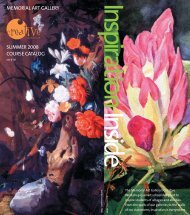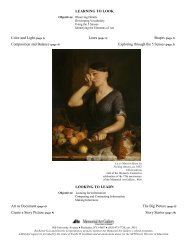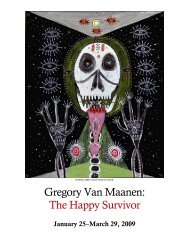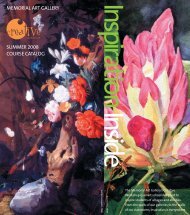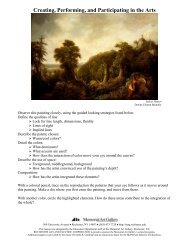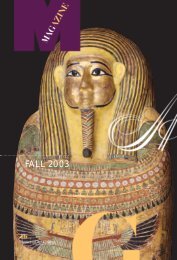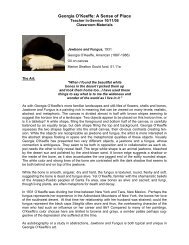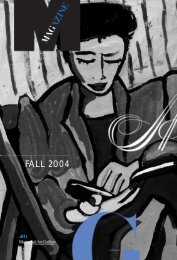Tradition in Transition: Russian Icons in the Age of the Romanovs
Tradition in Transition: Russian Icons in the Age of the Romanovs
Tradition in Transition: Russian Icons in the Age of the Romanovs
Create successful ePaper yourself
Turn your PDF publications into a flip-book with our unique Google optimized e-Paper software.
ast Meets West<br />
When <strong>the</strong> people <strong>of</strong> Rus’ accepted Christianity from Byzantium<br />
<strong>in</strong> 988, <strong>the</strong>y <strong>in</strong>herited a mature religious tradition, consist<strong>in</strong>g <strong>of</strong> a<br />
coherent and <strong>the</strong>ocratic world view. One manifestation <strong>of</strong> this world<br />
view was <strong>the</strong> mak<strong>in</strong>g and veneration <strong>of</strong> icons. The purpose <strong>of</strong> <strong>the</strong><br />
icons, as with all Byzant<strong>in</strong>e art, was to support <strong>the</strong> relationship<br />
between <strong>the</strong> liturgy and ritual <strong>of</strong> <strong>the</strong> Orthodox Church. Additionally,<br />
<strong>the</strong> veneration <strong>of</strong> icons served as a personal l<strong>in</strong>k between <strong>the</strong><br />
worshipper, <strong>the</strong> figure honored by <strong>the</strong> icon, and <strong>the</strong> ideals <strong>the</strong>y<br />
represented. Descendants <strong>of</strong> Greco-Roman funerary portraits and<br />
later <strong>the</strong> mosaics at Ravenna, Italy, Byzant<strong>in</strong>e icons could trace<br />
<strong>the</strong>ir aes<strong>the</strong>tic l<strong>in</strong>eage to <strong>the</strong> early days <strong>of</strong> Christianity; this connection<br />
imbued <strong>the</strong>m with both symbolic and historic significance.<br />
<strong>the</strong> central image. Considered to be <strong>the</strong> Gospel <strong>in</strong> pa<strong>in</strong>t, early icons<br />
were prized for <strong>the</strong>ir endur<strong>in</strong>g consistency <strong>in</strong> an ever-chang<strong>in</strong>g<br />
world, and <strong>the</strong>y were understood to represent a direct and faithful<br />
connection to <strong>the</strong> true and never-chang<strong>in</strong>g word <strong>of</strong> God. Essentially<br />
copies <strong>of</strong> one accepted orig<strong>in</strong>al, <strong>the</strong>ir unwaver<strong>in</strong>g cont<strong>in</strong>uity was<br />
favored over <strong>in</strong>dividual artistic <strong>in</strong>terpretation.<br />
The later icons <strong>in</strong> this exhibition also have <strong>the</strong>ir roots <strong>in</strong> Byzantium,<br />
yet like all works <strong>of</strong> art, <strong>the</strong>y reflect <strong>the</strong> time <strong>in</strong> which <strong>the</strong>y were<br />
made. With <strong>the</strong> advent <strong>of</strong> Russia’s new relationship with <strong>the</strong> West,<br />
<strong>the</strong> taut symbolism <strong>of</strong> <strong>the</strong> early icons began to give way to artistic<br />
license and <strong>the</strong> elements found <strong>in</strong> representational pa<strong>in</strong>t<strong>in</strong>g. The<br />
taste for naturalism, popular <strong>in</strong> 17th- and 18th- century European<br />
pa<strong>in</strong>t<strong>in</strong>g, soon <strong>in</strong>filtrated <strong>the</strong> realm <strong>of</strong> <strong>the</strong> icon pa<strong>in</strong>ters: outl<strong>in</strong>es<br />
s<strong>of</strong>tened, figures became fuller, Renaissance perspective was<br />
employed, and shadows appeared. Once portrayed as distant and<br />
div<strong>in</strong>e, Christ and <strong>the</strong> sa<strong>in</strong>ts were now depicted as more man than<br />
god, more mortal than immortal.<br />
Roman funerary portrait.<br />
Mosaic <strong>of</strong> Christ Pantocrator from Ravenna.<br />
The earliest icons favored by <strong>the</strong> <strong>Russian</strong> Orthodox Church<br />
adhered conceptually and stylistically to icons brought from<br />
Byzantium. Characterized by a directness and flatness, <strong>the</strong> imagery<br />
favored simplified forms, and <strong>the</strong> figures floated <strong>in</strong> spiritual space.<br />
A limited palette, m<strong>in</strong>imal detail, severe l<strong>in</strong>es, and a penetrat<strong>in</strong>g<br />
gaze kept <strong>the</strong> viewer focused on <strong>the</strong> div<strong>in</strong>e and spiritual nature <strong>of</strong><br />
Icon <strong>in</strong> <strong>the</strong> traditional Byzant<strong>in</strong>e style.<br />
Icon show<strong>in</strong>g Western <strong>in</strong>fluences.
A Curatorial Conundrum<br />
The Puzzle <strong>of</strong> MAG’s St. George Slay<strong>in</strong>g <strong>the</strong> Dragon<br />
by Nancy Norwood<br />
Curator <strong>of</strong> European Art, MAG<br />
St. George and Russia<br />
Based on style, color, and formal characteristics, <strong>the</strong> icon St. George Slay<strong>in</strong>g <strong>the</strong> Dragon<br />
entered MAG’s collection as orig<strong>in</strong>at<strong>in</strong>g <strong>in</strong> <strong>the</strong> mid-1300s from <strong>the</strong> <strong>Russian</strong> city <strong>of</strong> Novgorod.<br />
As <strong>the</strong> patron sa<strong>in</strong>t <strong>of</strong> Moscow and <strong>of</strong> <strong>the</strong> <strong>Russian</strong> pr<strong>in</strong>ces, St. George played a special role<br />
<strong>in</strong> Orthodox religious practice and was a frequent subject <strong>of</strong> icon pa<strong>in</strong>t<strong>in</strong>gs. Accord<strong>in</strong>g to<br />
Christian tradition, George, who was born dur<strong>in</strong>g <strong>the</strong> third century <strong>in</strong>to a Christian family,<br />
jo<strong>in</strong>ed <strong>the</strong> Roman army. Dur<strong>in</strong>g his travels, he came across a city that was be<strong>in</strong>g terrorized<br />
by a dragon. At <strong>the</strong> moment <strong>of</strong> George’s arrival, <strong>the</strong> dragon, who had already eaten all<br />
<strong>of</strong> <strong>the</strong> farm animals and had begun to consume <strong>the</strong> townspeople, was prepar<strong>in</strong>g to swallow<br />
<strong>the</strong> k<strong>in</strong>g’s daughter. With <strong>the</strong> help <strong>of</strong> Christ, George overcame <strong>the</strong> dragon and killed him<br />
with his spear, thus sav<strong>in</strong>g <strong>the</strong> city from ru<strong>in</strong>. He later became a sa<strong>in</strong>t when he was martyred<br />
by <strong>the</strong> Romans for his Christian beliefs.<br />
The most popular depiction <strong>of</strong> St. George <strong>in</strong> <strong>Russian</strong> icons represents his struggle with <strong>the</strong><br />
dragon, a scene that also represents <strong>the</strong> victory <strong>of</strong> Good over Evil. MAG’s St. George<br />
follows <strong>the</strong> iconography prevalent among icon pa<strong>in</strong>ters <strong>in</strong> <strong>the</strong> city <strong>of</strong> Novgorod, where<br />
<strong>the</strong> sa<strong>in</strong>t was particularly admired. Cloaked <strong>in</strong> a red mantle and mounted on a white horse,<br />
George stabs <strong>the</strong> dragon directly through <strong>the</strong> mouth with his spear as <strong>the</strong> dragon’s body<br />
is trampled by <strong>the</strong> horse’s hooves. A protective angel hovers near George’s head, while<br />
<strong>the</strong> hand <strong>of</strong> God reaches toward him from <strong>the</strong> upper right corner <strong>of</strong> <strong>the</strong> pa<strong>in</strong>t<strong>in</strong>g. The red<br />
color <strong>of</strong> <strong>the</strong> cloak symbolizes <strong>the</strong> blood <strong>of</strong> martyrdom; <strong>the</strong> white horse represents Div<strong>in</strong>e<br />
Light. The small images <strong>of</strong> sa<strong>in</strong>ts that appear on <strong>the</strong> left and right sides also suggest<br />
Novgorod as <strong>the</strong> place <strong>of</strong> orig<strong>in</strong>, as patrons <strong>the</strong>re frequently commissioned icons with<br />
sa<strong>in</strong>ts who held special personal significance. Those sa<strong>in</strong>ts served as protectors <strong>of</strong> both<br />
<strong>the</strong> <strong>in</strong>dividual patron and <strong>the</strong> icon itself.<br />
Courtesy <strong>Russian</strong> Museum, St. Petersburg. Courtesy Hillwood Museum & Gardens Wash<strong>in</strong>gton, D.C. Courtesy State Tretyakova Gallery, Moscow. Courtesy <strong>Russian</strong> Museum, St Petersburg.
Rochester History<br />
St. George Slay<strong>in</strong>g <strong>the</strong> Dragon arrived <strong>in</strong> Rochester around<br />
1920 via <strong>the</strong> world-renowned landscape architect and Pittsford<br />
native Fletcher Steele, who acquired it dur<strong>in</strong>g a brief sojourn<br />
<strong>in</strong> Russia immediately after World War I. Anecdotal evidence<br />
suggests that he obta<strong>in</strong>ed it through a <strong>Russian</strong> friend, although<br />
he did once write about <strong>the</strong> chaotic conditions at <strong>the</strong> Hermitage<br />
after <strong>the</strong> Revolution: “Anyone <strong>the</strong>re now can purchase some <strong>of</strong><br />
<strong>the</strong> greatest works <strong>of</strong> art for only 50 kopeks <strong>in</strong> real cash.”<br />
When Fletcher Steele died <strong>in</strong> 1971, <strong>the</strong> icon became, through<br />
his bequest, <strong>the</strong> property <strong>of</strong> <strong>the</strong> Rochester Historical Society.<br />
Fletcher Steele<br />
At a silent auction held for <strong>the</strong> benefit <strong>of</strong> <strong>the</strong> Society, Pr<strong>of</strong>essor<br />
George Ford and his wife Patricia, who had made four trips to Russia and were especially<br />
entranced by medieval icons, saw <strong>the</strong> St. George and purchased it for <strong>the</strong>ir home. Experts<br />
on <strong>Russian</strong> art who later exam<strong>in</strong>ed it called <strong>the</strong> icon a rare and remarkable classic example<br />
<strong>of</strong> Novgorod icon pa<strong>in</strong>t<strong>in</strong>g. At that time, <strong>the</strong> Fords felt that <strong>the</strong> icon should be safeguarded<br />
for future generations, and generously donated it to <strong>the</strong> Memorial Art Gallery.<br />
The Conundrum<br />
From <strong>the</strong> time that Fletcher Steele acquired <strong>the</strong> St. George until 1993, when an <strong>in</strong>terested<br />
conservator consulted with <strong>Russian</strong> colleagues, <strong>the</strong>re was no doubt that <strong>the</strong> icon was<br />
exactly what it was purported to be—medieval, <strong>of</strong> exceptional quality, and very rare.<br />
There were several repairs to <strong>the</strong> damaged board on which it was pa<strong>in</strong>ted, <strong>in</strong>clud<strong>in</strong>g <strong>the</strong><br />
addition <strong>of</strong> a new cradle support to <strong>the</strong> back. Cracks had been repaired, and both<br />
pa<strong>in</strong>t<strong>in</strong>g and gild<strong>in</strong>g had been refreshed dur<strong>in</strong>g <strong>the</strong> course <strong>of</strong> <strong>the</strong> icon’s long and difficult<br />
life. It was common practice to extend <strong>the</strong> life <strong>of</strong> <strong>the</strong>se sacred pa<strong>in</strong>t<strong>in</strong>gs through such<br />
<strong>in</strong>terventions, and many icon pa<strong>in</strong>ters were tra<strong>in</strong>ed <strong>in</strong> complex restoration techniques.<br />
<strong>Russian</strong>s began actively collect<strong>in</strong>g icons <strong>in</strong> <strong>the</strong> 1840s, and <strong>the</strong> prices for old icons reached<br />
<strong>the</strong>ir peak just prior to <strong>the</strong> outbreak <strong>of</strong> World War I. Then, <strong>in</strong> <strong>the</strong> 1920s, <strong>the</strong> anti-religious<br />
activities <strong>of</strong> <strong>the</strong> Soviet regime released large quantities <strong>of</strong> icons onto <strong>the</strong> <strong>in</strong>ternational art<br />
market, and foreign private collectors and museums began to amass <strong>the</strong>ir own collections.<br />
Some icon pa<strong>in</strong>ters served this emerg<strong>in</strong>g Western market through renewal and restoration—<br />
as well as deliberate falsification. As a result, many icons that arrived <strong>in</strong> <strong>the</strong> West dur<strong>in</strong>g<br />
that time have become suspect and are be<strong>in</strong>g re-evaluated, both through iconography, style,<br />
and <strong>the</strong> use <strong>of</strong> advanced technologies.
Revisit<strong>in</strong>g MAG’s St. George<br />
In 1993, <strong>the</strong> icon was sent to a conservation lab because <strong>of</strong> its fragile condition. A conservator<br />
with a special <strong>in</strong>terest <strong>in</strong> icons took photographs and pa<strong>in</strong>t samples to Russia <strong>in</strong> order to<br />
consult with icon specialists. One felt that St. George was a wonderful example <strong>of</strong> 16thcentury<br />
icon pa<strong>in</strong>t<strong>in</strong>g; ano<strong>the</strong>r, however, felt that despite similarities to o<strong>the</strong>r Novgorod<br />
icons <strong>of</strong> St. George, <strong>the</strong> draw<strong>in</strong>gs and proportions <strong>of</strong> MAG’s icon were questionable.<br />
While acknowledg<strong>in</strong>g that it was imperative to exam<strong>in</strong>e <strong>the</strong> icon <strong>in</strong> person, she suggested<br />
that it could date to <strong>the</strong> 1500s but was at some po<strong>in</strong>t damaged and repa<strong>in</strong>ted, or that it<br />
could be a forgery on an old board. Technical analysis <strong>of</strong> two pa<strong>in</strong>t samples was <strong>in</strong>conclusive.<br />
Despite <strong>the</strong> fact that <strong>the</strong> medieval blue pigment azurite was found <strong>in</strong> one <strong>of</strong> <strong>the</strong> small<br />
sa<strong>in</strong>ts <strong>in</strong> <strong>the</strong> border, <strong>the</strong> <strong>Russian</strong> analyst felt <strong>the</strong>re should be more natural pigments overall.<br />
Future Exploration<br />
In May <strong>of</strong> 2008, MAG began work<strong>in</strong>g with imag<strong>in</strong>g specialist Dan Kushel <strong>in</strong> <strong>the</strong> Art<br />
Conservation Department at Buffalo State University, one <strong>of</strong> <strong>the</strong> pre-em<strong>in</strong>ent conservation<br />
tra<strong>in</strong><strong>in</strong>g programs <strong>in</strong> <strong>the</strong> United States. To date, he has performed both x-ray and <strong>in</strong>frared<br />
imag<strong>in</strong>g, which suggest <strong>the</strong> pa<strong>in</strong>ter followed traditional practices. In <strong>the</strong>se images,<br />
<strong>the</strong> icon is seen through<br />
x-radiography (left), <strong>in</strong>frared<br />
reflectography(IRR)(center)<br />
and high-resolution photography<br />
taken under visible<br />
light (right). X-rays can<br />
reveal changes that may have<br />
occurred throughout <strong>the</strong><br />
history <strong>of</strong> <strong>the</strong> work, particularly as <strong>the</strong>y regard types <strong>of</strong> pigments and metals. The x-ray<br />
allows us to see “through” <strong>the</strong> icon. The grid pattern is a cradle, or support, that was<br />
added to <strong>the</strong> icon <strong>in</strong> <strong>the</strong> late 19th or early 20th century. An open-weave fabric is visible<br />
<strong>in</strong> several areas, but it is unclear whe<strong>the</strong>r this fabric is <strong>the</strong> orig<strong>in</strong>al support for <strong>the</strong> gesso<br />
or was added later to support areas <strong>of</strong> damaged wood. IRR imag<strong>in</strong>g is particularly useful<br />
for study<strong>in</strong>g <strong>the</strong> preparatory stages <strong>of</strong> a work, <strong>in</strong>clud<strong>in</strong>g identify<strong>in</strong>g any draw<strong>in</strong>g or<br />
pa<strong>in</strong>t<strong>in</strong>g that lies under <strong>the</strong> visible layer <strong>of</strong> pa<strong>in</strong>t. Nei<strong>the</strong>r is apparent <strong>in</strong> this image,<br />
although it is clear that no additional pa<strong>in</strong>t layer has been added on top <strong>of</strong> <strong>the</strong> varnish.<br />
Future plans <strong>in</strong>clude dat<strong>in</strong>g <strong>the</strong> wood through <strong>the</strong> science <strong>of</strong> dendochronology and more<br />
comprehensive pa<strong>in</strong>t analysis. Most importantly, experienced specialists will exam<strong>in</strong>e<br />
<strong>the</strong> icon with attention to structure, design, and style. Despite <strong>the</strong>se efforts, we know <strong>the</strong>re<br />
may never be a conclusive answer to <strong>the</strong> question <strong>of</strong> whe<strong>the</strong>r <strong>the</strong> icon is a forgery or<br />
restored orig<strong>in</strong>al. Whatever <strong>the</strong> results, however, St. George Slay<strong>in</strong>g <strong>the</strong> Dragon will<br />
rema<strong>in</strong> an <strong>in</strong>valuable and educational work <strong>in</strong> <strong>the</strong> Memorial Art Gallery’s collection.<br />
The MAG gratefully acknowledges Dan Kushel, pr<strong>of</strong>essor <strong>of</strong> Technical Exam<strong>in</strong>ation and Documentation <strong>in</strong> <strong>the</strong> Art Conservation<br />
Department at Buffalo State University, who generously donated his time and expertise to provide us with <strong>the</strong>se images.


